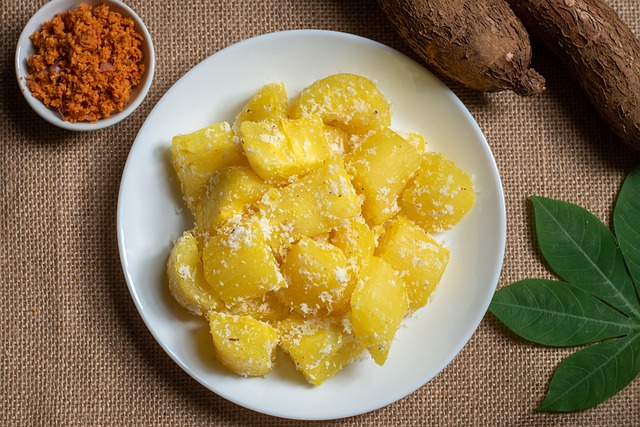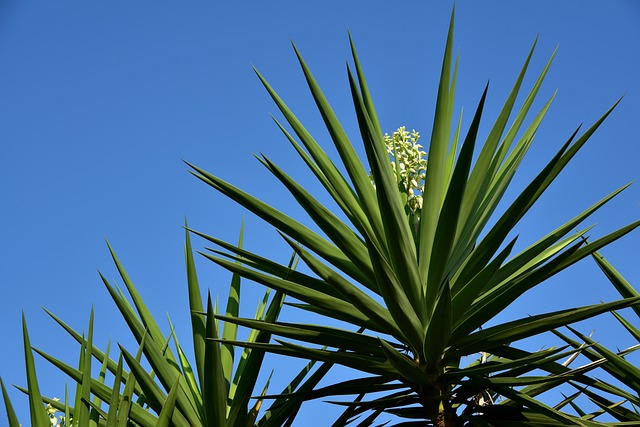Are you curious about the differences between yuca vs yucca? Yuca, also known as cassava, is found throughout Central and South America while Yucca is native to dry regions of North and Central America. Despite sharing similar names, they are two distinct plants with some key differences that we’ll explore in this blog post. We’ll examine the nutritional benefits each provides along with its uses in different culinary dishes so that you can make an informed decision when considering these species for your next meal!
Table of Contents
What Is Yuca?
Yuca is a starchy edible root, originating in the Caribbean and Central America. It is also known as cassava, manioc, and mandioca, and is widely cultivated around the world for its nutritious tubers. Yuca has a thick brownish skin and white or yellow flesh; it’s similar in texture to potatoes when cooked. It is a great alternative to traditional starches like potatoes, rice, corn, and wheat.
Yuca has been consumed by people around the world for centuries. Indigenous South Americans depended on it as an essential staple food source before European colonization; today it continues to provide important nutrition to many areas of Latin America and Africa. Yuca contains several essential vitamins and minerals, including calcium, phosphorus, iron, zinc, magnesium, folic acid, potassium, thiamine (vitamin B1), riboflavin (vitamin B2), niacin (vitamin B3). It also provides dietary fiber that may help reduce cholesterol levels.
In addition to being eaten as a side dish or boiled/fried snack similar to French fries or chips, yuca can be used in various recipes such as soups or stews; boiled with spices; cut thin like noodles for stir-fries; turned into patties; mashed into puree with eggs for pupusas; grated for pancakes; turned into tapioca pudding or flan; mashed into dough with lard and vegetables for empanadas; slices soaked in milk with sugar for dulce de yucca (a sweet dessert); blended with fruit juice to make smoothies/drinks/ice cream; even as flour or starch added to baked goods!
Yuca is very versatile in terms of culinary uses and health benefits alike. Consuming yuca on a regular basis can help promote healthy bones and teeth due to its high levels of calcium and phosphorus content; provide energy through carbohydrates found within the tuber itself; aid digestion thanks to its dietary fiber content which helps regulate bowel movements and satiety levels throughout the day; increase immunity levels due to its high concentration of vitamin C found within the tuber itself—which can help prevent illnesses such as colds or flu—and lastly reduce blood pressure levels thanks to its good sources of potassium which counteract sodium’s effects on blood pressure regulation levels.

What Are The Health Benefits Of Yuca?
The health benefits of yuca, also known as cassava or manioc, are numerous and varied. Yuca is a root vegetable that has been consumed by cultures around the world for centuries. It is a staple in many countries and can be used in a variety of dishes. Not only does it have great taste, but it also provides many essential nutrients to the body.
One of the most important benefits of yuca is its high carbohydrate content. A single cup of cooked yuca contains over 33 grams of carbohydrates as well as 6 grams of dietary fiber. This combination helps to provide sustained energy throughout the day and can help keep blood sugar levels stable. The dietary fiber found in yuca may also help support digestive health and regular bowel movements.
Yuca is also rich in essential vitamins and minerals including vitamin C, potassium, magnesium, copper and phosphorus. Vitamin C plays an important role in immune system function as well as skin health while potassium helps maintain healthy blood pressure levels and muscular function. Additionally, magnesium supports bone health while copper aids in red blood cell formation and phosphorus helps with energy metabolism processes within the body.
In addition to the vast array of vitamins and minerals found in yuca, it is also an excellent source of plant-based proteins. A single cup of cooked yuca contains 4 grams of protein which can benefit muscular growth, repair and maintenance within the body. Yuca consumption has even been shown to increase HDL cholesterol (the good kind) levels without impacting LDL cholesterol (the bad kind).
Finally, consuming yuca may also help reduce inflammation due to its natural phytonutrients such as polyphenols, flavonoids and phenolic acids which all have antioxidant properties that help combat oxidative stress caused by free radicals. Many studies have linked a decrease in inflammation with a decrease in chronic illnesses such as diabetes, heart disease and cancer risk factors – making this root vegetable an all-around superfood!
What Are Some Of The Most Popular Dishes That Use Yuca?
Yuca is a starchy, tuberous root vegetable that is an important source of carbohydrates in many regions around the world, particularly in Latin America, Africa, and Asia. It is also known as cassava or manioc and is widely used for its versatile culinary applications. Here are some of the most popular dishes made with yuca:
– Yuca Frita: Also known as yuca fries, this dish is made by slicing yuca into sticks or wedges and deep frying them until they become golden and crispy. Yuca frita is a popular side dish served with main courses such as fried fish or grilled meats, but it can also be enjoyed on its own as a snack.
– Tostones: Tostones are a popular Caribbean snack made by twice-frying thin slices of green plantains that have been flattened until they become crispy and golden brown. They are often served with garlic sauce or mayonnaise dip. Similarly to yuca frita, tostones can be enjoyed alone as a snack or served as a side to accompany other dishes like sandwiches or salads.
– Casabe: Casabe is a traditional Venezuelan flatbread made from finely grated yuca that has been mashed into a dough-like consistency and then cooked over an open flame until it becomes crisp and golden brown on both sides. It’s commonly eaten for breakfast alongside cheese or eggs, but can also be served as an appetizer with dips such as guacamole or salsa.
– Chicharrón de Yuca: Chicharrones are crunchy pork rinds typically found in Central American cuisine. Yucas version of this snack consists of thin slices of yucca that are boiled until softened before being deep fried into crunchy bits which can be sprinkled over soups or salads for an added crunchy texture.
– Bollo de Yuca: This sweet bread roll is popular among many Latin American cultures such as Cuba and Colombia where it’s traditionally served for breakfast along with hot chocolate or coffee to start off the day! The dough for bollo de yuca consists of grated yucca mixed with coconut milk and sugar before being formed into small balls before baking in the oven.
What Is Yucca?
The Yucca is a genus of perennial shrubs and trees that is part of the Agavaceae family. It is native to North America, Central America, and the Caribbean. The Yucca plant has numerous species, including Yucca aloifolia, Yucca filamentosa, and Yucca glauca.
The plant features stiff sword-shaped leaves in sharp points with white flowers that bloom during the summertime. Its trunk is usually branched or unbranched and can reach heights of up to 20 feet tall. The roots are deep-running and can reach lengths of up to 15 feet. Many species produce edible fruits called “dates” which have a sweet fruit taste similar to sweet potatoes.
Yucca plants are often used for landscaping purposes due to their hardiness and low maintenance requirements. They are especially popular in desert regions such as Arizona, Nevada, Texas, California, and New Mexico where they thrive in dry climates with plenty of sun exposure. In addition to landscaping uses, traditional cultures around the world have utilized various parts of the yucca plant for many centuries as food sources, medicines, dyes, soap ingredients, rope fibers and more.
The medicinal properties of yucca plants have been used successfully for treating arthritis symptoms as well as reducing inflammation related pain in joints or muscles after exercise or physical activity. Furthermore some studies suggest that consuming yucca root extracts may help reduce cholesterol levels in some individuals as an adjunct therapy when taken along with a healthy diet plan over long periods of time.
In conclusion the yucca is not only an attractive ornamental plant but also provides numerous medicinal benefits for those who consume it regularly or utilize its extracts for health purposes. This versatile plant can be grown outdoors or indoors depending on environmental conditions making it easy to cultivate anywhere from gardens to patios and balconies during summer months even in cold climates.

What Are The Benefits Of Yucca?
One of the biggest benefits of yucca is its nutritional value. This plant is packed with essential vitamins and minerals, such as potassium, vitamin C, and fiber. It also has high concentrations of antioxidants, which help protect against damage from free radicals and inflammation. Additionally, it contains some useful compounds that can aid in digestion, such as saponins. Furthermore, yucca can assist in maintaining healthy cholesterol levels and blood sugar regulation.
Yucca also provides a number of health benefits due to its anti-inflammatory properties. Studies have shown that the juice from yucca root can reduce inflammation in arthritis sufferers and alleviate symptoms like swelling, pain, stiffness, and joint immobility. In addition to this benefit for those with joint pain issues, some research suggests that drinking yucca juice may promote kidney health by reducing the risk of certain kidney diseases.
Another major advantage of eating yucca is its potential for aiding weight loss efforts. It is a low calorie food that is high in dietary fiber – about four grams per cup! – which helps you feel fuller for longer periods of time. It also contains resistant starch; this type of starch does not break down during digestion so it remains in your GI tract longer than other carbohydrates which can help people manage their hunger throughout the day better.
Finally, yucca also boasts a variety of skin care benefits when applied topically or consumed orally. Its high levels of vitamin C make it an ideal ingredient for brightening skin tone while its anti-inflammatory properties are great for soothing irritated skin conditions like eczema or psoriasis flare-ups. Additionally, it’s rich in antioxidants which help protect against environmental aggressors like UV radiation and pollution to help keep your skin young looking and vibrant!
How Do I Use Yucca?
Yucca can be used in many ways both as food and for medicinal purposes. Here is a list of possible uses for this plant:
– Roast the root to make chips or mash it among other vegetables.
– Use the leaves and flowers to create a tea that can help with digestion, arthritis, headaches, and hypertension.
– Make soaps from processed Yucca extract that are great for skin ailments such as eczema and acne.
– Add sliced Yucca roots to salads or soups for added flavor.
– Boil the root before roasting or baking it to soften it up, similar to potatoes.
– Use ground Yucca flour as an alternative wheat flour when baking breads or cakes.
– Boil the lily pads and fry them like regular green beans for added texture in dishes such as stirfries.

>>> You might also like:
Best deep fryer consumer reports
Yuca Vs Yucca Comparison
Yuca vs. Yucca is an interesting comparison, as the two plants look remarkably similar but have a few key differences. Yuca (Manihot esculenta), also known as cassava, is a woody shrub native to South America and is widely grown throughout the tropics for its edible root. It has become one of the most important sources of carbohydrates in many tropical countries due to its hardiness and ability to be stored after harvest. Yucca (Yucca brevifolia) on the other hand, is a perennial shrub native to North America characterized by sword-like leaves and dramatic white flowers.
The similarities in appearance between yuca and yucca can make it difficult to tell them apart with just a casual glance. Both plants have long stems that grow from a central base, with wide pointed leaves arranged in a spiral around them. Yuca’s leaves are thinner than those of yucca, however, and tend to have serrated edges while yucca’s are smooth-edged. The roots of both plants are edible; yuca’s fleshy tubers are usually cooked before eating, while yucca’s root can be eaten raw or cooked like potatoes.
When it comes to their uses, both plants have benefits that make them useful in different ways: Yuca is an important source of carbohydrates in many tropical countries and its starch is used as a thickening agent in food processing; while Yucca is often used as an ornamental plant due to its attractive foliage and flowers. In terms of medicinal benefits, both plants contain compounds that have been found beneficial for treating various health conditions such as arthritis pain relief and asthma symptoms.
Yuca vs yucca – One final major difference between these two plants lies in their growth habits – yuca grows quickly in moist soil with full sun exposure whereas yucca needs dry soil and partial shade for optimal growth conditions. This means that if you want either plant for its ornamental value or culinary uses, you will need to plan accordingly – planting your chosen species in the right environment will ensure that you get the best possible results!
>>> How to Make Yuca Fries and Sudada
Conclusion: In conclusion, the differences in yuca vs yucca are clear. Yuca is a starchy root crop with many culinary uses, while yucca is an ornamental succulent plant native to the Americas. While they have some similarities in spelling and pronunciation, their uses are vastly different. Knowing these facts can help prevent confusion between the two plants and help make sure you don’t go planting a meal for dinner instead of decorating your home.
As there are many types of yucca plants and varieties of ways to use yuca in cooking, we encourage you to do more research on both species to find out more about them. Whether you’re interested in growing an ornamental plant or adding a unique flavor element to your favorite dish, understanding yuca vs yucca can open up new opportunities for exploration. We hope this blog post has cleared up exactly what makes these two plants so special and distinct.
The Cafetoscanarestaurant blog is all about great food and good times. We’ll give you the latest news on what’s happening in the restaurant scene, share our favorite recipes, and more.

